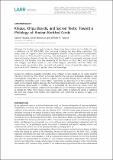Khipus, khipu boards and sacred texts : toward a philology of Andean knotted cords
Abstract
Although the knotted cord texts known as khipus have been created in the Andes for over a millennium (ca. AD 950–1950), their historical philology has been little understood. This study, based on original archival and ethnographic research, analyzes hybrid khipu/alphabetic texts known as “khipu boards,” examining their development in colonial Peru, and their role in twentieth-century Andean rituals. Particular attention is paid to a previously unknown sacred manuscript, the Entablo, from the community of San Pedro de Casta, Peru, which describes how villagers used khipu boards in their annual religious ceremonies until the 1950s. This study reveals new insights into the social and symbolic nature of post-Inka khipus as texts, particularly with reference to gender, place, and knowledge.
Citation
Hyland , S , Bennison , S & Hyland , W P 2021 , ' Khipus, khipu boards and sacred texts : toward a philology of Andean knotted cords ' , Latin American Research Review , vol. 56 , no. 2 , pp. 400-416 . https://doi.org/10.25222/larr.1032
Publication
Latin American Research Review
Status
Peer reviewed
ISSN
0023-8791Type
Journal article
Description
This research was funded by the National Geographic Society, the Leverhulme Trust, the John Simon Guggenheim Foundation, and the University of St. Andrews.Collections
Items in the St Andrews Research Repository are protected by copyright, with all rights reserved, unless otherwise indicated.

